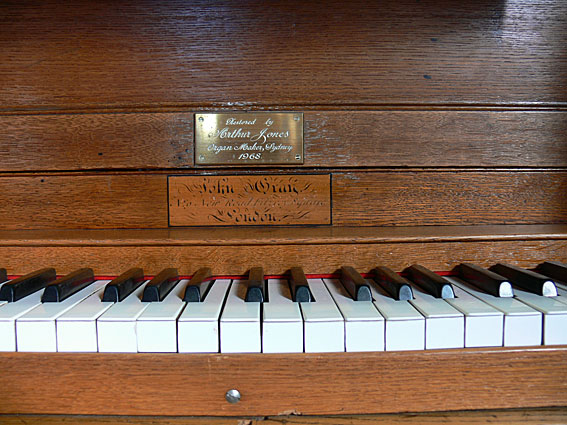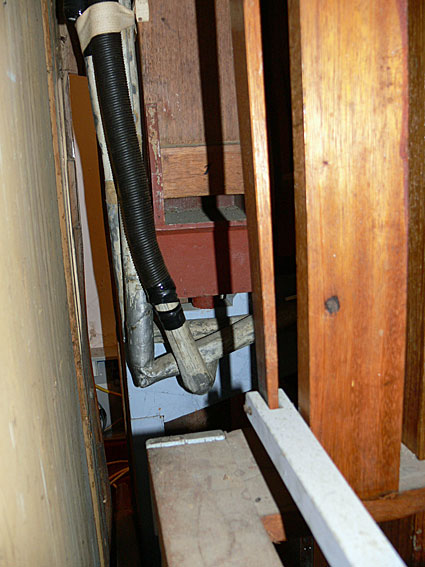© OHTA (last updated May 2011)

St Matthew's Anglican Church, Rokeby : exterior
[photograph by John Maidment (27 April 2011)]

St Matthew's Anglican Church, Rokeby : exterior
[photograph by John Maidment (27 April 2011)]
Historical and Technical Documentation by John Maidment
© OHTA (last updated May 2011)

St Matthew's Anglican Church, Rokeby : exterior
[photograph by John Maidment (27 April 2011)]

St Matthew's Anglican Church, Rokeby : exterior
[photograph by John Maidment (27 April 2011)]
The foundation stone of St Matthew's was laid in June 1840 and the building dedicated in September 1843. It was designed by architect James Blackburn in a simplified Gothic style with a tower at the west end and crenellated parapets.1 The building is constructed from sandstone and of interest for its diminutive scale.

St Matthew's Anglican Church, Rokeby organ
[photograph by Trevor Bunning (23 December 2008)]

St Matthew's Anglican Church, Rokeby : organ – Dr Geoffrey Cox demonstrating the instrument
[photograph by John Maidment (27 April 2011)]
The organ was built by John Gray, of New Road, Fitzroy Square, London in 1824 for St David's Church, Hobart, and first used for services on 15 May 1825.2 It was built under the superintendence of George Cooper, organist of St Sepulchre's Church, London.3 The following poem was published to greet the arrival of the organ in Hobart:
An Ode
Addressed to the Organ of St. David's Church
Ave Tasmania ! the long expected sail,
Favoured at length by some auspicious gale,
Arrives : - at length the Lady East appears,
And of her safety now are hushed all fears,
From Antipodean realms late news she brings
And full two hundred men seat here for sins :
Nor is this all – but stop ! the heav'nly sacred throng !
Must be invoked, before another line
Is penn'd. Oh muses, heav'nly sacred throng !
To whom the powers of verse belong :
On thee I call to aid my feeble song –
On thee I call to lend thy pow'rful aid ;
(Thanks to the muse, 'tis sooner done than said)
How in the ship, then sacred nine repeat
What merchandize, and stores, and salted meat,
What pickled pork, and tripe, and other things
She, in her spacious hold, together brings.
And now, O muse ! once more I call on thee,
To say what else came in her o'er the sea :
What else ! – ah now's the glorious theme !
The "Organ" has arrived, and's to be seen
In David's Church; - and there in awful state
It stands majestic, - this, the will of fate !
Inexorable fate has doomed it there to stand
The Organ metropolit' of this land.
For ever and for ever ! – ah. – but whence
Has come this mighty far-tamed Organ hence.
From London it hath come, from Fitzroy-square,
And live (the names I do forget) the makers there.
No sooner was the bark in sight of shore,
Than mountains whistled, * never known before – Inspired by music, all Tasmania danced,
The women sung, - and the horses pranced !
The billows heav'd (as usual) and the sun
Its usual course throughout the heavens ran.
Nature, it seemed, upon that awful day
Had clad herself in all her bright array.
The "Organ" came, paced up and stowed in hemp,
Immortal be the name of far fam'd Kemp ! –
I've done. – The muse departs, - enough is said –
The Organ's up, and yes – the money's paid !!
* The tune is not precisely known4
In June 1857 it was reported that a new organ for St David's, built by Bishop & Starr, of London had arrived in Hobart and that tenders were invited for its erection.5
The Gray organ was moved to St Matthew's Church, Rokeby, where it was installed by J. Pollard in August 1857.6 James J. Pollard was trained as an organbuilder in England with Gray & Davison and in piano making with Collard and Collard. He appears to have arrived in Hobart c.1856 when he advertised frequently in the Hobart Town Mercury as the Pianoforte & Organ Manufactory, 138 Elizabeth Street.7

St Matthew's Anglican Church, Rokeby : console
[photograph by John Maidment (27 April 2011)]

St Matthew's Anglican Church, Rokeby : drawstops, left jamb
[photograph by Trevor Bunning (27 April 2011)]

St Matthew's Anglican Church, Rokeby : drawstop engraving
[photograph by Trevor Bunning (27 April 2011)]

St Matthew's Anglican Church, Rokeby : nameplates
[photograph by John Maidment (27 April 2011)]
The organ received a restoration in 1968 by Arthur Jones.8 It remains substantially intact, although the Mixture that was originally provided for is no longer present; it may have been prepared-for initially, or it could have been removed, in line with the tastes of the times. At this time, tuning slides were added to the metal pipework and some of the original lead conveyances to the bass pipes were replaced in plastic. The building frame and reservoir were also painted in a non-historic colour.
It is of particular interest for its retention of the original GG compass, the divided Sesquialtera and Cornet, and the provision of a shifting movement pedal to cut out the upperwork. The oak casework is also significant, although the wooden dummy facade pipes have been overpainted. The original console fittings: drawstops and engraved labels and painted nameboard also survive.
| Manual Open Diapason Stop Diapason Principal Twelfth Fifteenth Sesquialtera [17.19.22] Cornet [12.15.17] Mixture |
[8] [8] [4] [2-2/3] [2] [III] [III] [II] |
oak trebles GG-Ten.B Middle C up missing |

St Matthew's Anglican Church, Rokeby : action and reservoir
[photograph by Trevor Bunning (27 April 2011)]

St Matthew's Anglican Church, Rokeby : pipework
[photograph by Trevor Bunning (27 April 2011)]

St Matthew's Anglican Church, Rokeby : replaced conveyancing
[photograph by John Maidment (27 April 2011)]
1 Dorothea I. Henslowe, Our Heritage of Anglican Churches in Tasmania (Moonah, Tas.: Mercury-Walch, c.1979), p.56
2 Hobart Town Gazette and Van Diemen's Land Advertiser, 13 May 1825, p.2
3 The connection between the Cooper family and the organbuilding firm of Gray is fully discussed by Nicholas Thistlethwaite in his article 'Reforming Organists : the Cooper Family of St Sepulchre's, Holborn', Journal of the British Institute of Organ Studies, vol 34 (2010), pp.82-115
4 Hobart Town Gazette and Van Diemen's Land Chronicle, 13 May 1825, p.3
5 Hobart Town Mercury, 29 June 1857, p.1
6 Ibid., 7 September 1857, p.2
7 Ibid., various advertisements by Pollard from the period
8 Nameplate affixed to console